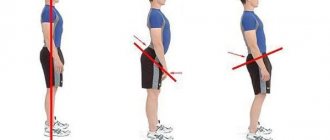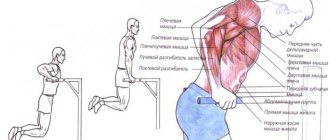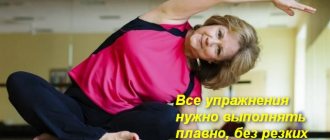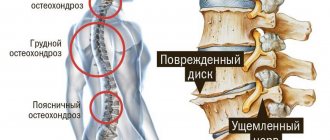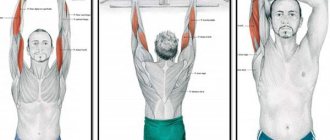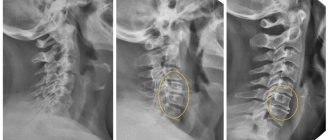Physical therapy (physical therapy) for cervical osteochondrosis is one of the most important factors in improving the patient’s condition and eliminating many symptoms of the disease.
Regular exercise therapy for cervical osteochondrosis can strengthen muscles, relieve muscle spasms, increase blood circulation and improve the condition of intervertebral discs. A properly selected set of exercises, when performed regularly, can help you get rid of many symptoms of cervical osteochondrosis - headaches, dizziness, pain in the shoulder and arm.
A physical therapy specialist will help you choose the most suitable set of exercises for your condition. Based on the examination data, the doctor can advise on the optimal load and recommend exercises that can be performed at home and in the workplace.
If you do not have the opportunity to consult a specialist, we offer you a simple set of exercises that can be performed in any conditions.
But when performing physical therapy exercises, it is important to follow certain rules so as not to harm the spine.
Be careful!
If you are concerned about cervical osteochondrosis, then when engaging in physical therapy, you must follow the following rules.
1. In the acute phase of the disease, exercise therapy is not prescribed. Doing exercises “through pain” should not be allowed.
2. Movements should be slow and unsharp.
3. Remember - with cervical osteochondrosis, circular movements of the head are unacceptable. You should also not throw your head back.
4. Do not use devices for traction of the cervical vertebrae without consulting a specialist - carelessness can cause serious injury.
5. If you have intervertebral hernias, be sure to consult your doctor!
Therapeutic exercises of the neck for osteochondrosis
The cervical region is one of the most vulnerable parts of the musculoskeletal system. This is not surprising, since the neck supports the head throughout the day and provides it with normal mobility. Without exercise and massage, during sedentary office work, osteochondrosis may occur, which is complicated by intervertebral hernias, muscle damage, pinched nerves and other pathologies.
Causes of osteochondrosis
At the beginning, the patient’s neck muscles become numb, a feeling of stiffness arises, and it becomes difficult to turn his head. At this stage, pathology can be prevented with massage and exercise. However, if measures are not taken, cervical osteochondrosis will soon develop.
With this disease, severe pain occurs, which intensifies when moving the head. The pathology is often accompanied by dizziness, fainting, migraines, and surges in blood pressure.
To get rid of the disease, some people start taking pills in an attempt to relieve pain. However, such treatment will not be beneficial, since without strengthening the muscles that form the “corset” that holds the spine, osteochondrosis will progress and the pain will intensify.
What causes provoke cervical osteochondrosis:
- Incorrect body position while working. The habit of sitting close to the monitor or bending low over papers leads to a change in the load on the spine and displacement of the vertebrae. An intervertebral hernia may develop, and the patient will have to undergo surgery.
- Congestion in the circulatory and lymphatic system. Sedentary work worsens blood and lymph flow. As a result, the neck tissues do not receive enough oxygen and necessary substances, which leads to their weakening and provokes osteochondrosis.
- Weakness of the neck muscles. The natural muscular corset should support the spine, preventing it from bending, keeping bones and cartilage from shifting. Therefore, lack of physical activity leads to osteochondrosis.
- Poor nutrition. Lack of vitamins and microelements in food causes weakening of cartilage, bones and muscles.
In order to prevent the development of osteochondrosis or slow down its progression, it is necessary to act simultaneously on all causes of the pathology:
- Lead a more active lifestyle that strengthens the musculoskeletal system.
- It is correct to sit at the table - do not hunch, do not bend too low.
- Periodically stretch your neck with exercises.
- Get massage regularly.
- Take vitamin supplements and complex preparations containing beneficial microelements.
Diseases of the cervical spine can cause dizziness and headaches
Large vessels pass through this part of the body, through which blood flows into and out of the brain. With osteochondrosis, this process is disrupted, which leads to a decrease in oxygen saturation of the brain. The result is dizziness, headache and fainting.
In this case, many patients begin to take medications for dizziness and painkillers, not realizing that treatment should begin with a visit to a vertebrologist and treatment of spinal pathologies.
An approximate set of exercise therapy exercises for cervical osteochondrosis (non-acute stage)
Exercise 1. Pre-warm-up.
As a warm-up, it is recommended to walk in place - on your full feet, then on your toes and heels. At the same time, the arms are relaxed, hanging freely, the shoulders are straightened and slightly lowered down. Duration - 2-3 minutes.
Exercise 2. Relaxing the neck muscles
Stand up straight with your arms hanging freely along your body. Clench your fists and tense your arms, while lowering your shoulders and shoulder blades and straightening your back. Hold the tension for 30 seconds, then relax and let your arms swing freely.
Exercise 3. Head tilts to the side.
Performed standing or sitting.
Gently tilt your head to the side, lowering your ear to your shoulder - feel the muscle stretch. Hold this for 10-15 seconds. Slowly return to the starting position. Tilt your head to the other side. Perform the exercise carefully, do not allow the pain to increase.
Exercise 4. Turning the head to the side.
Performed standing or sitting.
Tilt your head down, trying to touch the jugular cavity with your chin. As if sliding your chin along the upper part of the sternum, turn your head to the right and hold it for 3-6 seconds. Then slowly turn it the other way. Repeat 5-7 times.
Exercise 5. Raise and lower your shoulders.
Performed standing or sitting.
Raise your shoulders as high as possible without moving them forward. Lower it, pulling it back slightly, as if straightening your shoulders. Repeat 6-8 times
Exercise 6. Moving your shoulders back and forth.
Performed standing or sitting.
Starting position - shoulders freely straightened and lowered. Raise your shoulders and move them forward. Return to starting position. Pull your shoulders back, trying to close your shoulder blades. Return to the starting position and repeat 6-8 times.
Exercise 7. Head tilts forward.
Performed standing or sitting.
Gently lower your chin to your chest, bending your neck forward. Keep your shoulders straight! Slowly straighten up. Repeat 6-8 times.
Exercise 8. Swing your arms back.
Performed standing or sitting.
Stretch your arms to the sides. Shoulders slumped. Press your shoulder blades toward your back. At the same time, the outstretched straight arms will move slightly back. Return to the starting position. Repeat 6-8 times. Don't move your arms, try to work only your back muscles.
Exercise 9. Circular rotations in the wrist joint
Performed standing or sitting.
Stretch your arms to the sides. Shoulders slumped. The arms are bent at the elbows, the hands are clenched into fists. Perform circular rotations in the wrist joint without lowering your elbows - 4 times in one direction, 4 times in the other. Repeat 4-6 times
Exercise 10. Circular rotations in the elbow joint.
Starting position - as in the previous exercise.
Perform circular rotations in the elbow joint without lowering your elbows - 4 times in one direction, 4 times in the other. Repeat 4-6 times
Exercise 11. Circular rotations in the shoulder joint.
Starting position - extend your arms to the sides. Shoulders slumped.
Perform circular rotations in the shoulder joint - 4 times in one direction, 4 times in the other. Repeat 4-6 times.
Exercise 12. Circular rotations in the shoulder joint.
Relax your shoulders and arms. Raise your arms up, hands relaxed. Drop your arms freely downwards. Breathing is free and deep. Repeat 4-6 times.
Read more about NANOPLAST forte
Six isometric exercises
With isometric gymnastics, the trained area of the body does not shift in space: that is, there will be no bends, turns, or swings.
You or your partner apply pressure to some part of the body, and use your muscles to counteract this pressure. The number of repetitions of this exercise complex for cervical osteochondrosis depends on the degree of your preparedness: it can be 3-4 repetitions on each side, or 6-8. The duration of resistance to the applied force during each repetition is 5–6 seconds.
The starting position for all exercises is below - sitting straight on a chair, feet shoulder-width apart.
№1
With the palm of your hand, press on the temple and cheekbone area on one side (left palm - left cheek, right palm - right cheek).
Tighten your neck muscles, providing resistance to your hand.
Repeat on the other side.
№2
Interlock your fingers. In this position, press on your forehead with your palms facing it.
By straining your neck, resist the pressure.
№3
Place your hands in fists under your chin and press your chin from bottom to top.
Without moving your head in space, provide resistance.
№4
Interlace your fingers behind your head. In this position, press on the occipital-parietal region with your hands, as if trying to lower your head onto your chest, and create counteraction with your head.
№5
Place your right hand with an open palm in the area of your left cheek and cheekbone. Press your hand on your face as if trying to turn it to the right. Create resistance using your neck muscles.
Repeat the exercise on the opposite side.
№6
Lower your head to your chest and cross your arms at the back of your head. Press with your hands on the back of your head, and use the forces of your neck muscles to counteract so as to slowly return your head to a vertical position.
Head tilt with hands behind back
Sit on a chair, straighten up. Clasp your hands behind your back and move them to the left. Slowly tilt your head to the left until a pulling sensation appears on the right side of your neck and hold in this position for 10 seconds. Return to the starting position, and then move your hands to your right side and tilt your head to the right. Repeat the exercise 10 times - five bends in each direction.
Photo: istockphoto.com
What methods are used?
Therapeutic exercises for osteochondrosis of the cervical spine are selected based on one of the methods developed by famous doctors. Their distinctive feature is their high efficiency, minimal number of contraindications and ease of implementation, even for people with undeveloped muscles. Popular sets of exercises include:
- Shishonin's gymnastics. It includes simple but effective approaches aimed at improving muscle condition. The advantage is the almost complete absence of contraindications and the versatility of the technique.
- Dikul's gymnastics. Exercise therapy to strengthen the neck muscles does not require the use of special devices and can be easily carried out even at home. But all actions must be carried out with the utmost caution, since incorrectly chosen intensity of exposure often leads to exacerbations.
- Bubnovsky's gymnastics. One of the popular methods of recovery after surgery or improving spinal mobility with osteochondrosis. It is prescribed even in the last stages, to normalize blood circulation and improve metabolism in tissues.
- Norbekov's gymnastics. Exercises for the neck help restore the natural movement of biological fluids, start the regeneration process and eliminate the unpleasant manifestations of osteochondrosis.
Patients are prescribed gymnastics, which combines statistical and dynamic exercises aimed at contracting and relaxing muscle muscles. Each action should be repeated 5-10 times. A correctly selected technique will eliminate accumulated salts and deposits, improve metabolic processes, and restore nervous tissue.
[node:field_similarlink]
General rules for performing home gymnastics
Classes should take place in a warm, pre-ventilated room. For training, you need to choose loose clothing that does not restrict movement, absorbs moisture well and allows air to pass through. In order for the therapeutic effect of therapeutic exercises to manifest itself as quickly as possible, you should follow all the recommendations of exercise therapy doctors:
- You need to exercise regularly for 15-30 minutes a day (best in the morning);
- if back pain occurs, you need to stop training and rest;
- loads should be increased gradually, without trying to perform technically complex exercises in the first lessons;
- movements should be smooth, slightly slow, with medium or low amplitude.
It is imperative to listen to your feelings. If after performing any exercise the stiffness in the spinal region disappears and a pleasant muscle tension is felt, then it should be repeated more often.
Exercises according to Bubnovsky
Rehabilitation doctor and famous chiropractor S. Bubnovsky developed a method for treating osteochondrosis using only certain movements. He recommends that patients stop taking analgesics and relieve pain through regular exercise.
| Therapeutic gymnastics according to the method of S. Bubnovsky | ||
| Cervical osteochondrosis | Thoracic osteochondrosis | Lumbar osteochondrosis |
| While sitting, make frequent, barely noticeable tilts of the head up and down, and then from side to side. | Stand up, spread your feet shoulder-width apart, clasp your fingers at the back of your head. Bend forward a little, make circular rotations with your elbows | While lying on your back, bend your legs and press them tightly together. Tilt both knees first to one side, then to the other |
| Lie on your back, raise your arms, press your legs together. Raise your upper body while stretching your neck | Stand up, straighten up, spread your arms. Turn from side to side, keeping your hands at the same distance | Lying on your back, clasp your knees with your hands. Perform the “boat” exercise, smoothly rolling up and down |
Indications for the use of therapeutic exercises
Exercise therapy for osteochondrosis of the cervical spine is indicated in such cases:
- clinical manifestations of cervical osteochondrosis;
- pain with a vertebrogenic cause;
- increased risk of damage to intervertebral discs with possible fusion.
Exercise therapy for cervical osteochondrosis is indicated at all stages of disease development


